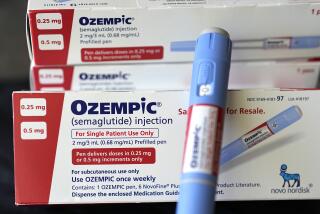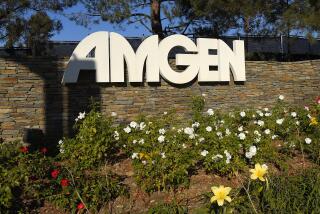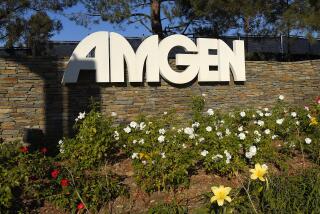Amgen Sets Its Sights on the Next Blockbuster : Biotechnology: Industry leader will begin human trials on hoped-for blood platelet growth factor. But competitors are close behind.
THOUSAND OAKS — For the moment, Amgen Inc. has a jump on its competition in the race to market a promising new blood hormone. And although it’s way too early to salute a medical breakthrough, analysts are saying nice things for a change. “We’re seeing the rebirth of a biotechnology company,” glowed Edmund A. Debler, an analyst with New York-based Mehta & Isaly. Just a year ago, Debler was bemoaning Amgen’s scanty research pipeline.
The Thousand Oaks-based biotech giant announced last month that it was ready to start human tests of the manufactured blood hormone, called MGDF. Shifting a drug study from test tubes to real people is an accomplishment. And Amgen is the first of three companies that has claimed to have cloned the hormone to do so. Biotechnology rivals Genentech of South San Francisco and Seattle-based Zymogenetics are expected to follow shortly with their own tests on humans.
MGDF, which stands for megakaryocyte growth and development factor, is a molecule Amgen cloned from a protein called thrombopoietin, which is manufactured by the body. This protein is thought to trigger the production of platelets--flat, rough-shaped blood cells that keep you from bleeding to death. It’s hoped that Amgen’s clone will do the same.
The drug will be tested on cancer patients undergoing chemotherapy, who often suffer from a lack of platelets as a side effect of their treatment. The condition is called thrombocytopenia, and platelet transfusions are the current remedy of choice.
Unfortunately, many people become resistant to transfusions over time. Once transfusions stop working, the choices are grim: Continue chemotherapy and risk bleeding problems, or stop and risk growth of the cancer.
*
Amgen currently has two biotechnology drugs on the market. Both are blockbusters. Epogen stimulates the production of red blood cells and is used to treat anemia, and Neupogen stimulates white blood cells and is used to ward off infections in cancer patients. In 1994, Amgen’s profit was $320 million on sales of $1.65 billion.
As the company has grown wealthy it has also boosted its research spending, pouring $320 million into R & D last year in the quest for blockbuster No. 3.
Amgen is conducting MGDF tests on an undisclosed number of cancer patients at the UCLA School of Medicine, Emory University School of Medicine in Atlanta, and in Melbourne, Australia. The tests will check the drug’s safety and effectiveness. If they pan out, the U.S. Food and Drug Administration will ask for further studies to determine dosages and nail down any other nagging questions about the pharmaceutical.
One of the UCLA volunteers, Pat Montague, 59, of Santa Barbara, was among the first subjects to be injected with Amgen’s molecule. Montague’s lung cancer was diagnosed in March. “I didn’t have anything to lose,” she said. Montague hopes the experimental drug will build up her platelet count in preparation for the chemotherapy regimen she begins this week.
Needless to say, the first company to market a platelet growth factor would eliminate the need for many transfusions and tap what some analysts estimate could be a more than a $200-million annual market. Analysts say Amgen’s quick progress to clinical trials is an encouraging sign for the company. But when CEO Gordon Binder told investors the good news at the annual shareholders’ meeting last week, he hastened to qualify it. Starting tests of the drug says nothing about whether it will prove effective, let alone safe. And it doesn’t even mean that Amgen will be awarded the leading patent on the drug.
What it does mean is that Amgen hasn’t been wasting time since July, when it announced that it had isolated the hormone in collaboration with Kirin Pharmaceutical Division, a unit of Japan’s Kirin Brewery Co. Analysts say it’s another sign that the company has been taking a bolder stance. They point, too, at recent acquisitions. “We’ve taken a lot of risks,” Binder told shareholders. “It’s a risky business and you can’t be in it without taking risks.”
That’s the kind of talk Wall Street likes to hear. “Given the amount of money they have, it’s exactly what [Amgen] should be doing,” said Jim McCamant, editor of the Medical Technology Stock Letter, which tracks the industry. Increasingly, he added, Amgen is “willing to spend money and make decisions. They were slow to do that before.”
While maintaining that Amgen “has always been a company willing to take risks,” company spokesman David Kaye acknowledges that things are looking brighter of late.
Amgen has six drugs that are being tested on humans or are in the analysis stage that follows such trials. These include proteins that may aid the fight against disorders that affect the brain and nervous system as Lou Gehrig’s and Parkinson’s diseases do. Amgen’s $255-million acquisition of Synergen Inc., a biotechnology company in Boulder, Colo., last fall put several potential winners into the company’s hands, including another anti-inflammatory drug that may help fight rheumatoid arthritis.
*
And earlier this year, Amgen paid New York’s Rockefeller University $20 million for a license to develop products based on the so-called “fat gene,” a gene cloned by Rockefeller scientists that is believed to cause obesity.
Further, Amgen is working on projects such as stem cell growth factor, which may serve as a helper drug to Amgen’s other blood factors. Add it all up, and you have “a well-focused company,” said Matt Geller, biotechnology analyst with New York-based Oppenheimer & Co.
“They know what they do best--blood cell factors--and they have the best ones,” Geller added. MGDF, like Neupogen and Epogen, is just such a blood cell growth factor. So it would seem a natural candidate for Amgen’s next success--”the third leg of a stool,” in the words of analyst Debler.
But in science there are no guarantees. Zymogenetics and Genentech, which announced the isolation of a platelet growth factor at about the same time Amgen did, are now presumably working furiously to move the substance to market.
Genentech and Zymogenetics won’t say much about it, but both say they will start tests on humans within the year. No one knows if they have isolated the same molecule as Amgen or whether any of these companies’ versions will work.
A thorny patent dispute seems inevitable. In the United States, such cases can involve hazy issues such as who conceived of an invention first. This is a particularly elusive point when the invention in question is partly a discovery. “With machines, the blueprints have already been done. It’s a lot less clear with a molecule,” said University of Michigan law professor Rebecca Eisenberg, a specialist in biotechnology patents.
For patients like Montague, what matters most is what role, if any, the drug will play in lowering the risk of thrombocytopenia. Either way, says UCLA cancer specialist Dr. Gary Schiller, MGDF should be kept in perspective. Thrombocytopenia is a problem for many but not all cancer patients. A good platelet-growth factor would help those at risk but represents only an incremental step in the larger battle against cancer.
MGDF could be “another arrow in the quiver,” said UCLA’s Dr. John Glaspy, who is overseeing the Amgen trials. “But it won’t tip the difference in terms of our ability to conquer the common malignancies. . . . A final answer to cancer, or even to low blood counts, it’s not.”
More to Read
Inside the business of entertainment
The Wide Shot brings you news, analysis and insights on everything from streaming wars to production — and what it all means for the future.
You may occasionally receive promotional content from the Los Angeles Times.










